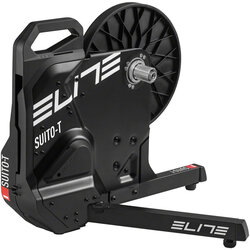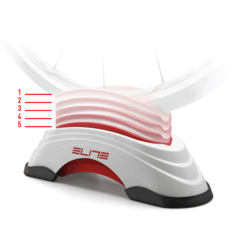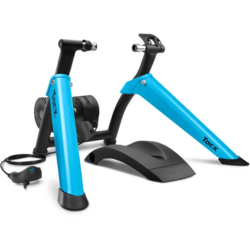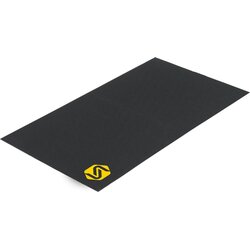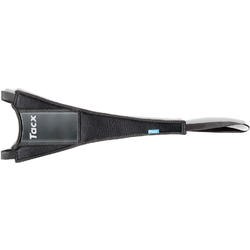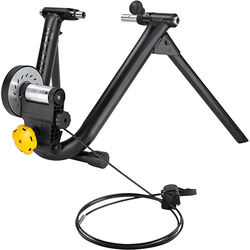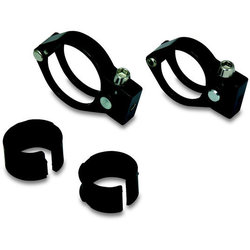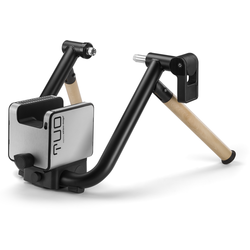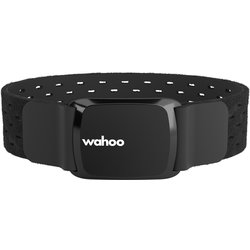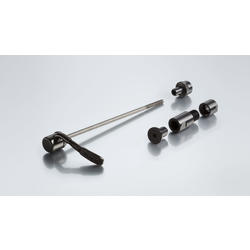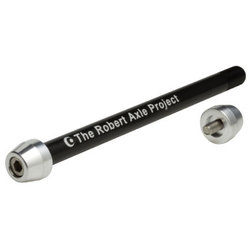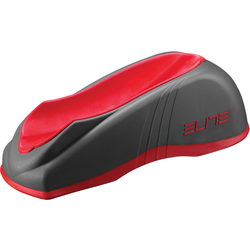Indoor Cycling Workouts | Tips And Tricks
|
Getting Started Riding IndoorsYou've got a bike. And, you've got an indoor trainer. You can ride all year, right? Many people don't find it so easy. The problem isn't physical, it's motivational. On the trainer you don't get to enjoy scenery, you don't have the distraction of changing terrain, and it's difficult to set up the head-to-head competition that makes outdoor cycling so exciting. |
| Get on the bike
Trainer time is TV time! Watching TV is one of the best ways to make trainer time pass fast. And, we're not talking boring old ad-riddled network TV, though that can have its uses (ride intensely during the show/rest during the ad/repeat). No, we use trainer time to catch up on all those favorites in our TiVo Season's Pass or cycling events caught on our DVR (digital video recorder). You could do the same with your VCR, remember those? These devices ensure that we always have a backlog of programs that we're looking forward to watching and lets us zap the commercials for non-stop entertainment, letting us watch the shows in less time, too. Plus, it's great to be able to do two things we love at the same time: go for a ride and watch our favorite shows.
Play, don't train. We also know riders who use PlayStations, Xboxes and GameCubes to keep them turning over the pedals for hours on end. The gaming console is hard to hold while riding so this should probably be left to slower, easily paused games. Try tunes, too. Cranking to your favorite tunes can be a great break from TV or reading. And, up-tempo beats are just the thing to make you maintain your cadence and intensity. Training Software: Today there are several options for software to aid you with your training efforts. You may have heard of Zwift, Trainer Road or The Sufferfest just to name a few. Another favorite riding software of ours Is Rouvy, a partner of CycleOps trainers. All the options mentioned will allow you to structure your riding time so it is fun and goes by fast, however be warned; you may find yourself wanting to ride longer because of the fun factor! Use A Virtual Or Smart Trainer: By using a software controlled virtual bike trainer you will get the most "real road" feel during your sessions. By syncing your unit up with whatever software platform you go with you will allow the software to control the resistance of the trainer, auto replicating climbs etc. like being outside! Indoor training is even more fun with friends. It's also motivating to ride with friends. And with indoor trainers, as long as you have a little space (a basement, garage, warehouse, etc.) it's easy for your buds to come over, set-up their trainers and spin with you. If you're on a cycling team, you can do team rides this way. Or, if you share goals with friends like completing an upcoming century, for example, this is a great way to motivate each other and improve your workouts with a little spirited competition and conversation. Or, maybe one of you has a nice new bigscreen TV and the other brings the latest DVD to watch and another the energy bars. Forget pajama parties. Hold trainer parties! No more excuses! We hope that these suggestions, tips and tricks help you get the most out of your indoor training this season and that the training helps you achieve all your riding and fitness goals. Who knows, you might even take to the nowhere bike with such a passion that you start preferring indoor riding to hitting the road? But, remember, that even if you just hit the trainer when the weather forces you to, every session over 30 minutes is a victory. You've stayed true to your goals and given your muscles the stimulus needed to maintain strength. We look forward to seeing you ride stronger than ever when the weather clears! |
Indoor Cycling Tips And Tricks
Most cyclists love to be outdoors, even in winter. After all, fresh air, sunshine and scenery are big attractions of the sport. If we wanted to exercise inside, we'd all become gym rats. 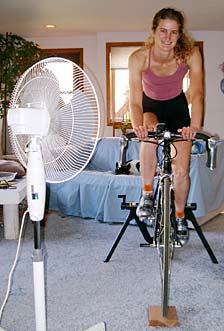
Indoor cycling is usually considered a last resort when weather makes it unpleasant to ride outside but many coaches recommend trainer workouts even if the sun is shining. "I'm a big fan of indoor trainer," says Chris Carmichael (Lance Armstrong's coach). "Indoor training is a necessity in winter, but I prescribe it to my riders all year round."
The benefits can be great, but there's a big problem: boredom. Watching sweat drip off your nose while hammering in your basement isn't quite as much fun as a spirited training ride in midsummer. But if you know a few tricks, indoor training is not only bearable but almost enjoyable. Because the trainer makes workouts predictable and repeatable, it's a great workout tool as well.
Advantages
- Train at any hour, day or night.
- Ride despite rotten winter weather.
- Save time. Dressing and undressing for outside rides takes precious minutes. Then you may have to spend more time washing and lubing your bike.
- Safety. When you ride indoors, there's no treacherous ice or traffic to pose a threat.
- Seize control. Riding a trainer allows you to precisely monitor each workout. That's why coaches love it. It's controllable and predictable so you can duplicate workouts and find out exactly how much you're improving. You determine the time and intensity of every session. Outside, all sorts of things can interfere. Plus, it's difficult and even dangerous to ride vigorously in frigid air. Winter clothes are restrictive. It's hard to warm up well in order to reduce the risk of injury. Once you do work up a sweat, a cold chill can set in to make the rest of the ride uncomfortable.
- Remember how to pedal. Spinning on a trainer after a crosstraining workout of weights, running, skiing or any other activity helps you retain your pedal stroke. It loosens leg muscles, too, reducing the soreness that can result from launching into unaccustomed, weight-bearing exercise.
Tips for successful indoor rides
Does it sound like I'm trying to talk you into something? Despite all the advantages I know that indoor training can be terminally boring. Time passes at a snail's pace because your mind isn't occupied with everything necessary to keep a 2-wheeled vehicle upright and on course. Indoor riding creates sensory deprivation equal to any devised in a psychology experiment. However, with the right approach, time on the trainer can be coaxed to flow along at normal speed. Here are some effective ways:
- Limit your riding time. An indoor trainer isn't for off-season endurance workouts. I'll bet most riders try at least once to ride their nowhere bike for 3 hours while watching football or reading War and Peace. They find out that once is more than enough. It's not very effective training, either. Crosstraining is a much better way to get off-season aerobic conditioning. So on the trainer, limit each workout to 60 minutes. Get on, warm up, do your workout, cool down and call it good. A trainer works great for short, intense, structured workouts. It becomes a torture machine for long steady-state rides.
- Vary every workout. Never do the same thing on a trainer for more than a few minutes at a time. Shift gears, stand up, pedal with one leg, go hard, go easy — anything to give your body and mind a break.
- Keep your mind occupied. On a trainer, your brain wants to dwell on time and discomfort. Stimulate it with music, movies, TV sports or even, if you're really desperate, soap operas or quiz shows. I like watching bike races. I tape the Giro, Tour and spring classics to use during the winter.
- Stay cool. Without a cooling wind, you'll heat up quickly while riding in your own stale indoor air. So, put a large fan a few feet in front of your face (photo) to create an artificial headwind. The stream of air will help evaporate the quarts of sweat you produce, keeping your core temperature down for a better, more comfortable workout. This is important, as indicated by the result of a recent lab study: Endurance time on a cycle ergometer at an intensity that could be maintained for 92 minutes when the temperature was 52 degrees decreased to 83 minutes at 70 degrees and to only 51 minutes at 86 degrees. The cooler you can make the indoor cycling environment, the more work you can do — and the greater fitness you can gain.
EXAMPLE! Steve Johnson, the head of USA Cycling, used to do his winter training in a janitor's closet at the University of Utah, where he headed the Human Performance Lab. Without air flow, his body heat would have quickly turned the closet into an oven. But with 2 big box fans blowing directly in his face, he kept his cool — and was able to build on his winter fitness to win the masters world road championship. |
- Drink up. Down at least one big bottle per hour while on the trainer, just like outside during a hot summer ride. Sports drinks work better than water because they replace carbohydrate, extending your energy.
- Train with others. Sign up for a cycling class at your local health club. Generically called "spinning" classes, these group hammer-fests are a great way to add variety and interest to your indoor riding and meet other fitness enthusiasts as well. Another approach is to start a "trainer night" at your home. San Diego cycling coach Arnie Baker, M.D., invites up to 70 members of the CycleVets club to his house one evening per week. They set up trainers on the patio and go through a specific workout. Then they order pizza and socialize.
- Study your form. A great way to improve your relaxation and form while training indoors is placing a large mirror where you can watch yourself while you're riding and ensure that you're maintaining a comfortable and efficient position.
TIP! This article is devoted to making the most of indoor cycling, but you should know that experienced riders usually don't get on their trainer frequently in the winter. They know that stationary cycling can be mentally taxing. If they use up their store of enthusiasm in January, they'll hate getting on the trainer in spring when bad weather interferes with riding the road. Instead, they crosstrain in winter and save the trainer for spring. Then when they need a hard workout but can't get outside, they don't mind climbing on their nowhere bike. |
9 Easy To Follow Indoor Cycling Workouts
Workouts developed by Road Bike Rider - Thank you!
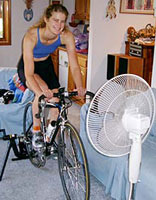 Trainer Workouts Using Segments
Trainer Workouts Using Segments
I use a segmented approach to indoor cycling workouts. Here's how it works:
- Each segment below is a self-contained workout spanning 15-20 minutes.
- Segments are designed to accomplish a specific training objective, such as warming up, improving speed or increasing power.
- Segments can be combined to fill the amount of time you want to spend on the workout.
- Segments can be chosen to pinpoint specific skills you want to improve.
Remember that these segments are samples; and I've provided a lot to choose from. Each workout suggests several variations, and variety is the key to enjoying (not just surviving) your time on the trainer. I have also included guidelines for those using perceived exertion ("hard," "easy," etc.) to gauge effort, and for those familiar with heart-rate exertion levels. Use the one you prefer. (It's a good idea to purchase a heart-rate monitor if you are training seriously.)
TIP! Gear suggestions are expressed as, for example 39x19. This means a 39-tooth chainring (a size found on many bikes) combined with a 19-tooth cog. |
Trainer workouts are limited only by your imagination. In fact, it's possible to train indoors 3 times per week for several months and never duplicate a workout. Make it your goal never to do the same one twice. Be creative!
The Workout Segment: Warm Up and Cool Down |
| Warm up (15 minutes). Start in a low gear of about 39x19, depending on the resistance of your trainer. Spin easily at about 70 revolutions per minute. Monitor your rpm by counting every time your right foot comes around during 30 seconds and multiply by 2. Each minute, increase cadence by several rpm. After 5 minutes, increase the gear. At the end of 15 minutes, you should be sweating lightly and your heart rate should be about 80 percent of max. Finish the warm-up with several 10-second sprints in a large gear. |
| Cool down (10 minutes). When the main workout is complete, decrease cadence and gearing on 1-minute intervals until you're spinning an easy gear at about 70 rpm. Then get off. |
The Workout Segment: Leg Speed (1) |
| Spin-ups (20 minutes) |
| In a low gear (39x19), spin at 70 rpm for 60 seconds. |
| Each minute, increase cadence by 5 rpm. You'll know when cadence gets too fast to sustain for 60 seconds because your butt will bounce on the saddle. |
| When you start bouncing, reduce cadence by 5 rpm every minute to the end of the 20-minute segment. |
The Workout Segment: Leg Speed (2) |
| Stand and sprint (20 minutes) |
| In a moderate gear (53x19), stand and sprint at about 100 rpm for 15 seconds. |
| Sit and spin the same gear gently for 45 seconds. |
| Repeat steps 1 & 2 four times. |
| In a fairly large gear (53x17), stand and sprint hard for 10 seconds. |
| Sit down, shift to a fairly low gear (39x17) and spin easily for 50 seconds. |
| Repeat steps 4 and 5 nine times. |
The Workout Segment: Leg Speed (3) |
| One-leg speed (20 minutes) Note: One-Leg Pedaling is explained below. |
| In a low gear (39x19), spin at 90 rpm for 15 seconds. Then pedal slowly for 45 seconds. |
| Repeat 4 more times, but increase your cadence during the first 15 seconds by 5 rpm each time. |
| Unclip your left foot. In a low gear (39x21), spin with your right leg for 60 seconds at about 100 rpm. |
| Do the same with the left leg. |
| Repeat steps 3 and 4 four times. |
| Using both feet, repeat steps 1 and 2. |
One-Leg-Pedaling Trainer Workout
One-leg pedaling is an extremely effective way to work on strength and add variety to your indoor training at the same time. When you pedal with both legs, the leg that pulls the foot through the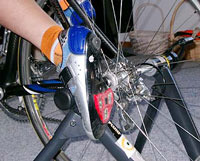 bottom of the stroke, up the back and over the top gets lazy. That's because the other leg is pushing the pedal down, a much more powerful and natural action than pulling the pedal up.
bottom of the stroke, up the back and over the top gets lazy. That's because the other leg is pushing the pedal down, a much more powerful and natural action than pulling the pedal up.
Now think about it. If your leg doesn't help bring the pedal up and over the top, it's just dead weight. It increases the resistance your muscles must overcome to move your bike down the road. This is why learning to pedal a complete, 360-degree circle with each leg makes you a better rider. One-leg pedaling drills teach your muscles and nervous system.
The Workout Segment: One-leg training |
| Warm up on the trainer for 20 minutes by pedaling with both legs. |
| Unclip your left foot from the pedal. Hook it back over the trainer just to the left of where it connects to the rear hub (photo). Or, rest it on a chair or stool just outside the left pedal circle. |
| Pedal at about 90 rpm with your right leg. Use an easy gear until you get accustomed to the unusual feeling. You'll probably find it difficult to pedal for more than 2 or 3 minutes the first time. The muscles that lift your thigh and push the pedal over the top will fatigue quickly. But you'll improve rapidly. |
| After a few minutes of using the right leg, switch to the left and pedal for the same amount of time. |
| As you improve, increase the gear and the amount of time you pedal with each leg. |
TIP! To simulate riding uphill, put a block of wood under the front wheel to tilt the bike. A 4- or 5-inch block will do it. |
The Workout Segment: Climbing Power (1) |
| Minute on, minute off (20 minutes) |
| In the saddle using a fairly large gear (53x17), pedal at 90 rpm for 60 seconds. This should raise your heart rate to within 5 bpm of your lactate threshold (LT). It should feel "hard." |
| Shift to the small chainring and spin easily for 60 seconds. |
| Repeat 9 times. During the final 3 efforts, your heart rate will climb to your LT or slightly above as you near the end of 60 seconds. |
The Workout Segment: Climbing Power (2) |
| Stand and ascend (20 minutes) |
| In a big gear (53x13), stand and pedal rhythmically for 2 minutes. Your heart rate should rise to about 5 bmp below your lactate threshold. It should feel "hard." |
| Sit down, shift to the small chainring and spin easily for 2 minutes. |
| Repeat 4 times. During the final 3 efforts, your heart rate will climb to your LT or slightly above as you near the end of the 2 minutes. |
The Workout Segment: Climbing Power (3) |
| Up and down (20 minutes) |
| In a moderate gear (53x19), pedal for 5 minutes at a cadence around 90 rpm. |
| Stand and shift to a cog that's 2 or 3 teeth smaller than you were in while sitting. For example, if you pedal seated in 53x19, shift to the 17 or even the 15 when you stand. Intensity should feel "hard." Your heart rate should rise to your LT in the last 2 minutes. |
| Sit down, shift to the small chainring and spin easily for 5 minutes to recover. |
| Repeat once. |
Indoor Riding & Weights
You don't need to stay on the trainer for an entire workout. For example, you can alternate 2- or 3-minute cycling intervals at about 85 percent of your max heart rate with leg presses, squats or step-ups. The weight workout improves strength. The pedaling intervals remind your legs and nervous system that you're a cyclist, too. This workout is a great way to create strength and begin the process of converting it to cycling-specific power.
The Workout Segment: Time Trial Power (1) |
| TT "threes" (20 minutes) |
| Ride for 3 minutes at a steady pace. Choose a gear that allows a cadence of 90-100 rpm but does not drive your heart rate past LT. It should feel "hard" but not exhausting. |
| Shift to the small chainring and pedal easily for 2 minutes. |
| Repeat 3 times. |
The Workout Segment: Time Trial Power (2) |
| TT ladder (20 minutes) |
| Choose a gear that lets you maintain a cadence of 90-100 rpm and a heart rate not exceeding your LT. It should feel "hard," but not exhausting. |
| Do a ladder like this: 1 minute hard, 1 minute easy 2 minutes hard, 2 minutes easy 3 minutes hard, 3 minutes easy 4 minutes hard, 4 minutes easy |
The Workout Segment: Time Trial Power (3) |
| TT "eights" (20 minutes) |
| Choose a gear that lets you maintain a cadence of 90-100 rpm and a heart rate not exceeding your LT. It should feel "hard, but not exhausting. |
| Ride at time trial cadence and intensity for 8 minutes. Check your cyclecomputer to see how far you go. Check your heart monitor to determine average heart rate. |
| Ride easily for 4 minutes. |
| Repeat the 8-minute TT and re-check distance and average heart rate. If you cover substantially less distance the second time, or your heart rate is more than 5 beats higher, it says you did the first effort too hard. |
The Workout Segment: Intervals (1) |
| Interval ladder (20 minutes) |
| Choose a gear that allows a cadence of 90-100 rpm for the length of each interval. Intensity should be "very hard" at the end of each work period. |
Do a ladder like this: |
The Workout Segment: Intervals (2) |
| Interval "threes" (18 minutes) |
| Choose a gear that allows a cadence of 90-100 rpm for the length of each interval. Intensity should be "very hard" at the end of each work period. |
| Ride hard for 3 minutes. |
| Shift to the small chainring and pedal easily for 3 minutes. |
| Repeat 2 times. |
TIP! This article is devoted to making the most of indoor cycling, but you should know that experienced riders usually don't get on their trainer frequently in the winter. They know that stationary cycling can be mentally taxing. If they use up their store of enthusiasm in January, they'll hate getting on the trainer in spring when bad weather interferes with riding the road. Instead, they crosstrain in winter and save the trainer for spring. Then when they need a hard workout but can't get outside, they don't mind climbing on their nowhere bike. |


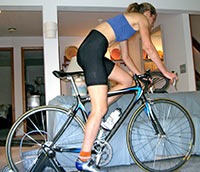 Don't let excuses keep you off the bike. Many riders moan about not being able to really ride on their trainer, to go for more than an hour or to get a good workout. We can tell you from long experience that you can do as much intensity and/or volume as you would outdoors just so long as long as you don't convince yourself otherwise ahead of time. And indoor rides like this are quality rides that'll get you fit and make you feel great. All it takes is believing in them and committing to them.
Don't let excuses keep you off the bike. Many riders moan about not being able to really ride on their trainer, to go for more than an hour or to get a good workout. We can tell you from long experience that you can do as much intensity and/or volume as you would outdoors just so long as long as you don't convince yourself otherwise ahead of time. And indoor rides like this are quality rides that'll get you fit and make you feel great. All it takes is believing in them and committing to them. 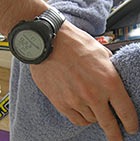 wattage for a set amount of time, or even a calorie target or specific drills. These all provide an excellent reason to keep pedaling. And, any measurement can work, as long as it interests and motivates you. Find the one that's best for you.
wattage for a set amount of time, or even a calorie target or specific drills. These all provide an excellent reason to keep pedaling. And, any measurement can work, as long as it interests and motivates you. Find the one that's best for you. 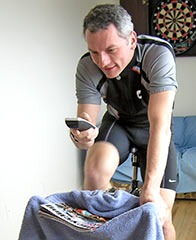
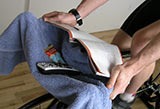 Reading works, too! This might surprise you but books and magazines are great distractions, too. You can prop them on your handlebars or hold them (photo) and unlike a movie or show that might slow or break for commercials, books will continue to engage you for as long as you want to ride (unless you're a speed reader). Consider starting with some pulp fiction. The light plots are engrossing and won't become too confusing if you miss a word or two due to your exertions. The limitation of reading is that it's hard to do while standing so we've found that it's best done in conjunction with TV. Try standing up every time your show comes back from commercial break and then start reading again at the next commercial break or vice-versa. Use your mute button to silence the TV so you can concentrate on your reading.
Reading works, too! This might surprise you but books and magazines are great distractions, too. You can prop them on your handlebars or hold them (photo) and unlike a movie or show that might slow or break for commercials, books will continue to engage you for as long as you want to ride (unless you're a speed reader). Consider starting with some pulp fiction. The light plots are engrossing and won't become too confusing if you miss a word or two due to your exertions. The limitation of reading is that it's hard to do while standing so we've found that it's best done in conjunction with TV. Try standing up every time your show comes back from commercial break and then start reading again at the next commercial break or vice-versa. Use your mute button to silence the TV so you can concentrate on your reading.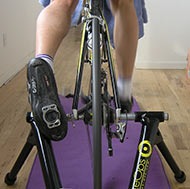 Keep focused with drills. Indoor rides provide an excellent opportunity to work on drills that you might not have the time or place to do outdoors due to the challenges of terrain, traffic and stop signs. The most well-known is one-legged riding. Pick a low number of sets and reps to start, say 3 sets of 30 pedal strokes for each leg, and build upon this in successive workouts. This drill helps you smooth your pedal stroke and increase leg speed. As the amount of sets and repetitions you can do increases, you'll finish off larger segments of riding time.
Keep focused with drills. Indoor rides provide an excellent opportunity to work on drills that you might not have the time or place to do outdoors due to the challenges of terrain, traffic and stop signs. The most well-known is one-legged riding. Pick a low number of sets and reps to start, say 3 sets of 30 pedal strokes for each leg, and build upon this in successive workouts. This drill helps you smooth your pedal stroke and increase leg speed. As the amount of sets and repetitions you can do increases, you'll finish off larger segments of riding time. 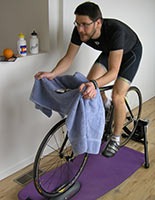 Time flies when you're going fast. Okay, time may actually pass very slowly when you're grinding out threshold or VO2 Max power but regular intervals break up the ride and make it easier to finish large blocks of time. 5 interval sets of 4 minutes on, 4 minutes off, easily eat up 36 minutes. Do a warm-up, several sets of intervals and a warm down and you'll put in 2 hours in no time.
Time flies when you're going fast. Okay, time may actually pass very slowly when you're grinding out threshold or VO2 Max power but regular intervals break up the ride and make it easier to finish large blocks of time. 5 interval sets of 4 minutes on, 4 minutes off, easily eat up 36 minutes. Do a warm-up, several sets of intervals and a warm down and you'll put in 2 hours in no time. 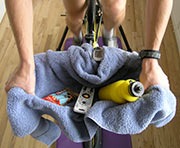 not only keeps sweat off the bike and floor, and keeps our hands dry, too, it also forms a simple pouch (photo) for the remote, books, energy bar, phone, etc.
not only keeps sweat off the bike and floor, and keeps our hands dry, too, it also forms a simple pouch (photo) for the remote, books, energy bar, phone, etc. 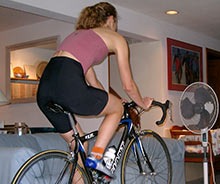 Get comfy, too. We recommend having at least one fan to keep you cool, better simulate outdoor riding and help evaporate sweat, which can soak your clothing and cause chafing otherwise. And, because indoor trainers transmit vibration through their metal frames, which places more pressure on delicate body parts, it's crucial to have a comfortable seat. A good saddle supports you by the sit bones, so you can stay seated comfortably as long as you like. TIPS: Regardless of how comfortable your saddle is, we recommend that you stand at at least 5- or 10-minute intervals. This serves to relieve pressure and also relieves the monotony of sitting in one place for a long time. Also, don't save your most comfortable cycling shorts for outdoor riding only. Wear them for indoor riding, too, because the sweet fit and well-placed padding can make the difference between a good ride and a bad one.
Get comfy, too. We recommend having at least one fan to keep you cool, better simulate outdoor riding and help evaporate sweat, which can soak your clothing and cause chafing otherwise. And, because indoor trainers transmit vibration through their metal frames, which places more pressure on delicate body parts, it's crucial to have a comfortable seat. A good saddle supports you by the sit bones, so you can stay seated comfortably as long as you like. TIPS: Regardless of how comfortable your saddle is, we recommend that you stand at at least 5- or 10-minute intervals. This serves to relieve pressure and also relieves the monotony of sitting in one place for a long time. Also, don't save your most comfortable cycling shorts for outdoor riding only. Wear them for indoor riding, too, because the sweet fit and well-placed padding can make the difference between a good ride and a bad one.